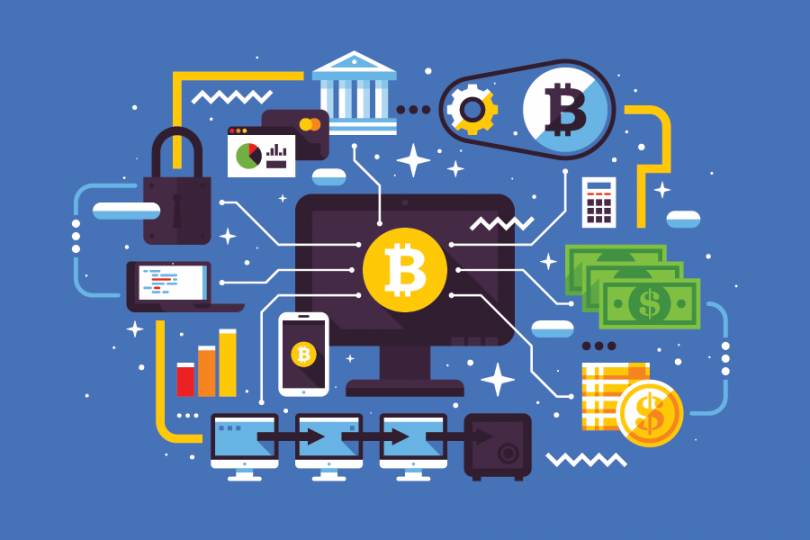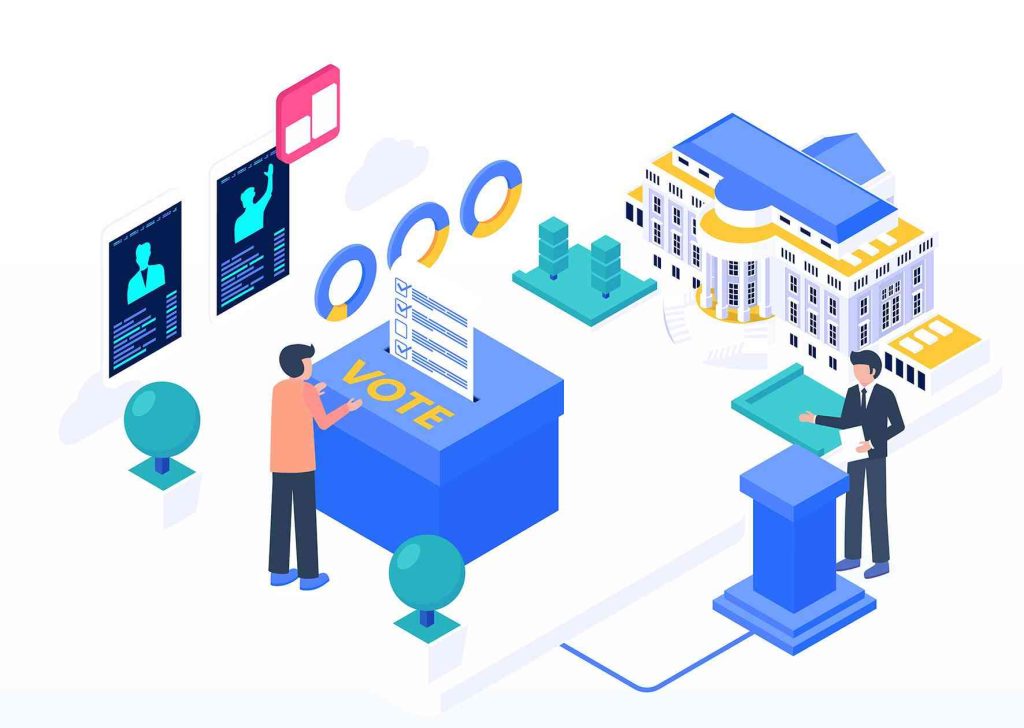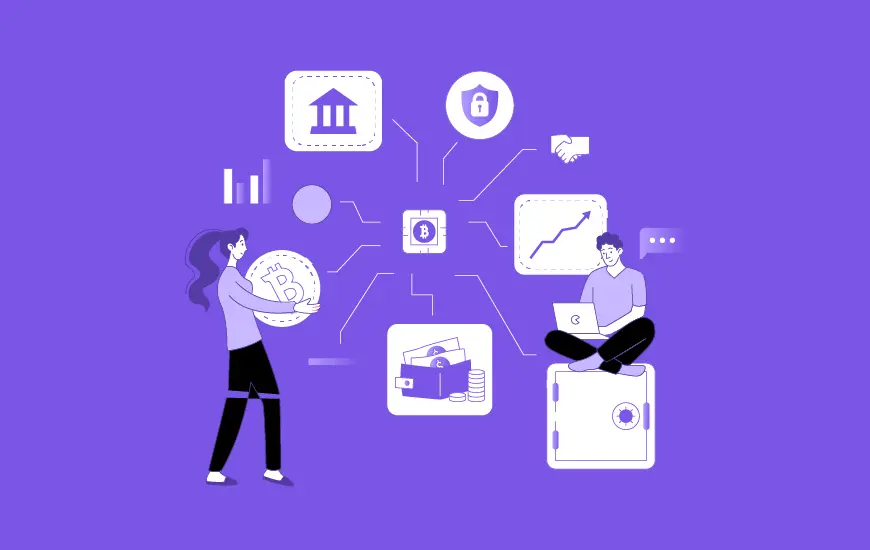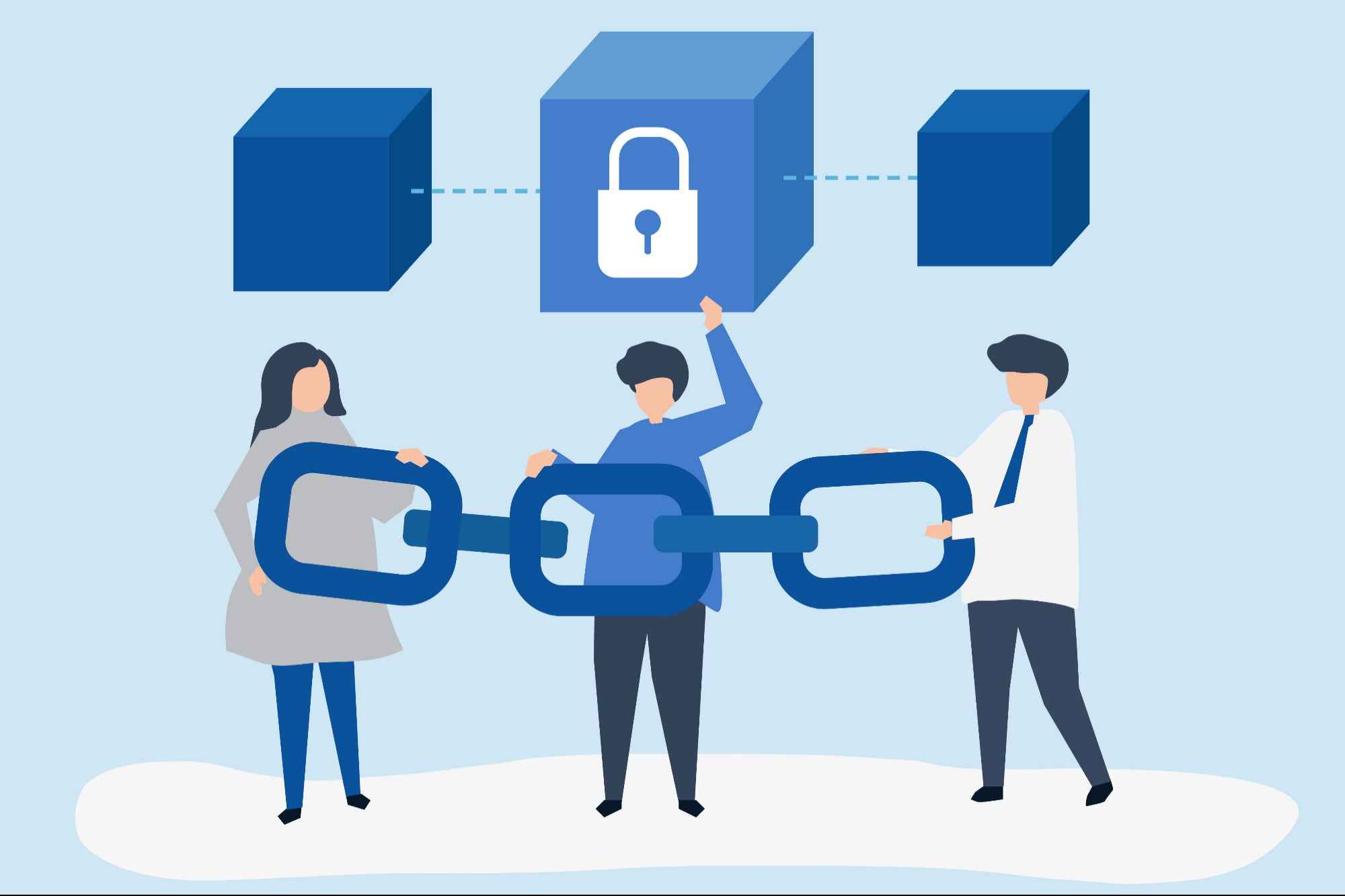Skeptical about elections? You’re not alone. I’m going to tell you how does blockchain prevent voter fraud? Imagine casting your vote knowing it’s safe from tampering. Blockchain could be the hero we’ve been waiting for. It’s revolutionizing how we think about secure votings. Join me, and let’s dive into a future where your vote isn’t just a whisper but an iron-clad scream for democracy.
Understanding Blockchain Technology and Its Role in Voting
The Fundamentals of Blockchain-Based Voting Systems
Think of blockchain as a secure digital box. It holds records of votes like precious gems. No one can break in. Once a vote goes in, it’s there for good. Now, let’s see how this tech keeps votes safe.
Every vote is a block, like a digital “I Voted” sticker. Each block links to the next by a unique code. Like an unbreakable chain, the links keep all votes in proper order. This is key to preventing fraud. No one can change a vote once it joins the chain. This is how blockchain makes our votes count—really count—and it does this in a way that’s clear for all to see.
Addressing the Double-Spending Problem in Blockchain Voting
What if someone tries to vote twice? In money terms, that’s like spending the same dollar two times. With voting, we call this the “double-spending” problem. It’s a big no-no. But wait—here comes blockchain, our election superhero, to save the day!
With this tech, your vote is a secure transaction. It checks if you voted before it lets you cast your vote. Imagine a ledger. It’s not a book, but a list everyone can see if they play by the rules. Your name gets checked off. No second vote for you, no siree! That’s how blockchain stops double votes. Simple, but oh so clever.
We’ve built trust in elections again with blockchain. The votes we cast are as safe as they can be. No extra votes, no vote-changing. Each vote is as unique as a fingerprint. This secures our voices in the choices our countries make. Isn’t that something to stand up and cheer about?
Blockchain hasn’t just changed the game. It’s flipped the playing board on fraud and said, “Not today!” As a voter, I know my vote matters. I put it in the chain, and there it stays—secure and counted. That’s the promise of blockchain for you, me, and voting free from fraud.
Enhancing Election Security with Decentralized Solutions
The Mechanisms of Preventing Electoral Fraud with Distributed Ledgers
Imagine we’re at a big table playing a game. We all watch the game pieces and nobody can cheat. That’s like blockchain technology in voting. All players, or voters, can trust the game. Blockchain is a digital ledger shared across many computers. No one can change it without everyone knowing. This stops bad players from cheating or committing fraud in elections.
Now, how does blockchain prevent electoral fraud? It does so by making a shared record that everyone can see, but no one can change once it’s written. When we vote, it records our vote like a digital promise that can’t be broken. No more fake votes or votes changing after the fact. It’s all out in the open on the blockchain for transparent voting.
Blockchain’s magic also works by using smart contracts for real-time vote tallying, this means we see votes counted as they come in, like a scoreboard that updates instantly. No waiting around, no room for sneaky business.
Immutable Voting Records and Real-Time Tallying Through Smart Contracts
Each vote is like a locked treasure secured with a special key. That’s the immutable voting records part. Once your vote is locked in, it stays that way. It’s secure like a treasure that nobody else can get to. Smart contracts make sure the votes add up correctly without any mistakes or meddling.
This method is like having an unbeatable security guard for every single vote. It ensures the votes are counted fair and square. People can watch the count and know for sure that no votes are added or missed. This makes it harder for anyone to mess up the count.
Peer-to-peer voting infrastructure in blockchain sets up direct connections between voters. No middlemen, less chance of someone doing something shady. Each computer in the network talks to the others, making sure all votes are legit and counted on time.
But what about trying to vote twice? The same technology that makes your online cash safe, cryptocurrency, stops this double-spending problem in voting too. Each vote is unique, like a special coin, so nobody can spend, or vote, twice.
Decentralized voting mechanisms are a game-changer. It’s like everyone watching each other’s backs in the voting world. We can all feel safer knowing our votes are secure and will count just like we cast them. It takes away the power from any one person or group to mess with the results.
This sort of technology isn’t just cool; it’s a big step toward making sure elections are fair and honest. Every vote is tracked on a blockchain ledger for vote tracking. This way, we can look back and check the votes if needed.
In short, chaining our votes in a blockchain brings a new level of trust into the picture. It’s the future of securing elections with blockchain. It means making every vote count, just like it should. This can help more people to trust the voting process, which could lead to more people voting. It’s all about keeping the vote honest and the voters happy.
Securing Voter Identity and Ballot Anonymity
Voter Identity Verification through Blockchain Advancements
Picture this: each vote safely tied to a voter, without revealing who they voted for. How? Blockchain brings in a strong way to check voter ID. This tech lets us check if a voter is real and should be voting. It’s like a guard at the ballot box, but smarter.
So, how does it work? Using blockchain for transparent voting isn’t tough. It starts when you join the voter list. A secure digital ID is made just for you on the blockchain. When voting time comes, you use this ID. It proves you’re you, but none can see your vote choice. This is how we fight fake votes and boost trust at the same time.
With blockchain, we make sure every voter’s vote counts. The system looks at the ID and says, “Yes, this person can vote.” And after that? It keeps your pick a secret. With every vote being a secret code, no peeking is possible.
Ensuring Anonymity in Blockchain Voting with Cryptography
Let’s shift gears to the silent hero: cryptography. This is like a spy’s best tool to keep messages secret. It takes your vote and scrambles it into code – a lock that’s ultra-hard to crack. Only at the end, systems with special keys can count all coded votes. Your name is never linked to your vote. It’s safe and private, thanks to cryptography.
With blockchain, your vote becomes a hidden gem in a big treasure chest. It’s mixed with all the others, but it’s still there, shining bright. And unlike tales of sunken loot, where pirates find the map, here the map is in bits and pieces. No one can put it together to steal your vote.
So, what’s the magic behind this? Cryptographically secure voting protocol. It might sound like a wizard’s spell, but it’s better. It makes sure that your vote stays a secret, from the start to end. Even I, as a blockchain wizard, can promise you that no one can break this spell.
Blockchain voting gives us a world where your vote is yours and yours alone. It’s like dropping your vote in an unbreakable box that only opens when all votes are in. Once it opens, your vote joins the others to shape the future, still wrapped in its secret cloak.
There you have it – a safe, clear path to punch your vote ticket, no fear of cheats.
To recap, blockchain stops fake votes and keeps true ones safe with two heroes: Digital IDs check voters are real, and cryptography keeps votes secret. With them, we can look forward to fraud-free elections. No meddling, no mess – just the real voice of the people. This is the future: secure, fair, and trusty. It’s our chance to make every vote truly count.
Auditing and Verifiability: Establishing Trust in Election Outcomes
The Role of Consensus Algorithms in E-Voting Verification
When we use blockchain for transparent voting, we get a big win – trust. How? Through this cool thing called consensus algorithms. In simple terms, they’re like the playground rules that help all the kids play fair. In blockchain voting, they ensure that every vote in an e-voting system blockchain gets checked and agreed on by multiple parties – which means no cheating!
This system works like an unbreakable promise. Every player in the network has to give a thumbs-up to all new votes, aka blocks, before adding them to the vote chain. If even one doesn’t agree, no go! So voter fraud? It’s much harder because faking a vote means you’d have to fool everyone at once. Imagine trying to sneak a fake bill past a crowd of eagle-eyed cashiers!
But it’s not just about catching the bad stuff. These algorithms also help correct honest mistakes like double-spending, where one vote tries to count twice. That’s a no-no, but don’t stress; blockchain has it in check.
Blockchain Infrastructure for Transparent and Auditable Elections
Alright, let’s talk infrastructure. The foundation that holds up our secure elections must be strong, right? Picture a town hall made of super legos – that’s blockchain infrastructure. Each lego piece is a block of data, and they fit so perfectly together that no one can pull them apart. So, immutable voting records for the win!
And guess what? This setup makes auditing blockchain votes a breeze. Since each block is locked tight with encryption, anyone who wants to check the score can do so without messing up the game. It keeps things fair and square, fostering that warm, fuzzy feeling of public trust in the electoral process.
What’s more, with smart contracts for votes tallying, it’s all automatic. As soon as a vote drops in the box, it zips into the tally. It’s like scoring a goal in soccer – the crowd goes wild because they see it happen in real-time. No waiting, no backroom counts, just straight-up, honest results.
And here’s the cherry on top – all the votes are traceable, but not like “I-know-what-you-did” traceable. More like “this-baby’s-legit” traceable. Your name isn’t on it, but your vote securely counts and no one can change it. That’s the magic of a decentralized voting mechanism.
With this kind of power, the voting process transforms. It isn’t just about casting a ballot; it’s about being part of a super-secure, cyber-protected fortress. This fortress not only defends against attacks but also builds a bridge of trust between voters and the system. It shouts loud and clear, “Hey, your voice matters, and we’ll guard it with our digital life!”
So, next time you hear about securing elections with blockchain, remember these two heroes – consensus algorithms and a bulletproof infrastructure. They’re not just fancy tech talk; they’re the guardians of your vote, delivering a fraud-free election straight to your doorstep.
We’ve explored how blockchain can change voting for the better. From basics to solving double votes, we see its power. It can stop fraud and lock in vote safety with smart deals that count votes fast. We learned that it can check who you are while keeping your choice secret, using tough code. Also, we looked at how blockchain makes sure election results are fair and that we can check them. Trust in votes matters, and blockchain could be key. Every vote must count, and using this tech can help us make sure they do. This is more than tech talk – it’s about keeping our votes safe and true. Let’s keep an eye on how blockchain voting grows. It might just shape our future in elections.
Q&A :
How does blockchain technology enhance election security?
Blockchain technology enhances election security through its inherent features of decentralization, immutability, and encryption. By distributing the information across a network of computers, it becomes nearly impossible for hackers to alter the data, thus preventing unauthorized changes to vote counts. Additionally, the cryptographic protection of each vote ensures that it cannot be tampered with once cast, further safeguarding the integrity of the voting process.
What are the mechanisms behind blockchain’s ability to prevent voter fraud?
Blockchain prevents voter fraud through a combination of transparency and cryptographic record-keeping. Each vote is recorded as a transaction, which is then verified and sealed into a block with a unique hash. This block links to the previous block, creating a chain that is extremely resistant to modification. The decentralized nature of the blockchain means that for any vote to be changed, a majority of nodes within the network would need to be compromised simultaneously, which is highly improbable.
Can blockchain technology be integrated into current voting systems?
Yes, blockchain technology can be integrated into current voting systems to enhance security and transparency. Governments and organizations are experimenting with blockchain-based voting systems, where votes are cast as digital transactions. While complete integration into existing structures may present challenges such as ensuring all voters have access to the necessary technology, the potential for a more secure and efficient voting process makes these efforts worth pursuing.
What are some examples of blockchain-based voting systems in use today?
Several blockchain-based voting systems have been used in recent years, including Estonia’s e-voting system and the MiVote platform in Australia. Pilot programs and trials have also been conducted in various locations, such as West Virginia, USA, where military personnel overseas were able to vote using a blockchain-based mobile application. These instances demonstrate the growing interest in and feasibility of blockchain in real-world voting scenarios.
How does blockchain ensure voter privacy while preventing fraud?
Blockchain ensures voter privacy while preventing fraud by utilizing cryptographic techniques such as anonymous credential systems or zero-knowledge proofs. These methods allow voters to prove their eligibility without revealing their identity. Moreover, votes are recorded on the blockchain as encrypted data, which can only be decrypted with the necessary keys, ensuring that personal information remains private, while the integrity of each vote is maintained.





RELATED POSTS
Cryptocurrency Analysis Method: Unveiling Market Trends with Precision
"Gain insights into cryptocurrency analysis...
Challenges Facing the Future of Blockchain: What Lies Ahead?
Challenges facing the future of...
Purple Bitcoin: A new currency in the digital world
Purple Bitcoin is a unique...
Decentralized Approaches to Blockchain Security: A New Era of Trust
Decentralized approaches to blockchain security:...
Don’t miss out on the DogX, Airdrop to X users
“DogX, Airdrop to X users”...
Blast Airdrop – Tips for Earning KRO Tokens Easily
Earning KRO tokens from the...
NebulaStride Airdrop – Tips to Maximize Income
To maximize your income from...
Bitcoin surges to $72,000 ahead of the U.S. elections
Bitcoin has experienced an impressive...
Can you short Bitcoin? – Exploring the Secret
Can you short Bitcoin? This...
Solayer Airdrop – Secrets to Maximizing Profits
To maximize profits from the...
Identity Management and Compliance Solutions: Navigating the Maze of Modern Security
Identity management and compliance solutions...
Bitlayer Airdrop and the opportunity to earn token exchange points
The Bitlayer Airdrop is not...
Challenges Of Implementing Blockchain For Businesses: Is Your Business Ready?
Navigate Blockchain Integration Barriers |...
Blockchain Breakthrough: Potential of blockchain in healthcare
Transforming Electronic Health Records (EHR)...
Explanation of Proof of Stake (PoS): Revolutionizing Cryptocurrency Security
Discover the Advantages of Proof...
James Seyffart: A leading expert on ETFs and Cryptocurrency
James Seyffart is a prominent...